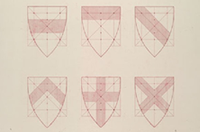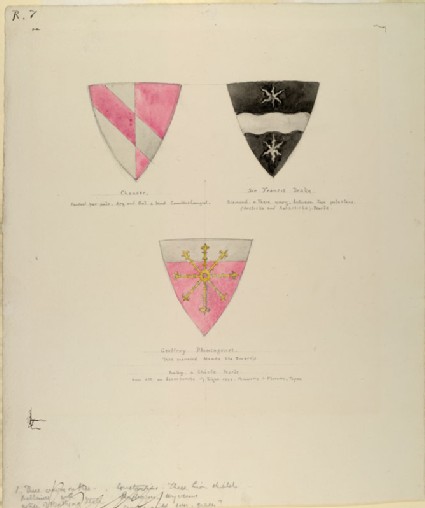Ruskin's revision to the Rudimentary series (1878)
Unpublished manuscript catalogue for proposed re-organisation of the Rudimentary series.

Ruskin's Catalogues: 1 object
Show search help- Reference URL
Actions
The Shield of Geoffrey Plantagenet, with the Shield of Chaucer, and of Sir Francis Drake John Ruskin
-
Ruskin text
R|8} The shield of Geoffrey Plantagenet, with the shield of Chaucer, and of Sir Francis Drake. M. (from Gwillim.) -
Details
- Artist/maker
-
John Ruskin (1819 - 1900)
- Object type
- drawing
- Material and technique
- watercolour over graphite on wove paper
- Dimensions
- 338 x 286 mm
- Inscription
- Recto:
below the upper left shield, in graphite: Chaucer. | Parted per pale, Arg and Gul. a bend Counterchanged.
below the upper right shield, in graphite: Sir Francis Drake. | Diamond. a Fesse wavy. between two polestars. | (Arcticke and Antarticke). Pearle.
below the lower shield: Geoffrey Plantagenet. | That married Maude the Empress. | Ruby, a Chiefe Pearle. | Over all. an Escarbuncle of Eight rays. Pommette & Florette. Topaz
bottom, from left, in graphite, struck out in ink, in two columns: 1. Three crowns on blue. | Bellinus with | notice of Watlynge Strete || Constantius. Three Lion shields | Pendragon. Wyverns | crosses with sun. green?
top left, in ink: R. 7
Verso:
bottom, right of centre, in graphite: R.8.
just to the right, the Ruskin School's stamp
- Provenance
-
Presented by John Ruskin to the Ruskin Drawing School (University of Oxford), 1875; transferred from the Ruskin Drawing School to the Ashmolean Museum, c.1949.
- No. of items
- 1
- Accession no.
- WA.RS.RUD.008
-
Subject terms allocated by curators:
Subjects
-
References in which this object is cited include:
References
Taylor, Gerald, ‘John Ruskin: A Catalogue of Drawings by John Ruskin in the Ashmolean Museum, Oxford’, 7 fascicles, 1998, Oxford, Ashmolean Museum, no. 248
Ruskin, John, The Ruskin Art Collection at Oxford: Catalogue of the Rudimentary Series, in the Arrangement of 1873, ed. Robert Hewison (London: Lion and Unicorn Press, 1984), cat. Rudimentary no. 8, RUD.008
Ruskin, John, Instructions in Practice of Elementary Drawing, Arranged with Reference to the First Series of Examples in the Drawings Schools of the University of Oxford (n.p., [1872]), cat. Rudimentary no. 8
Ruskin, John, Instructions in the Preliminary Exercises Arranged for the Lower Drawing-School (London: Smith, Elder, 1872), cat. Rudimentary no. 8
Ruskin, John, Instructions in the Preliminary Exercise Arranged For the Lower Drawing-School (London: Spottiswoode, 1873), cat. Rudimentary no. 8
Ruskin, John, ‘Rudimentary Series 1878’, 1878, Oxford, Oxford University Archives, cat. Rudimentary no. 3
Ruskin, John, ‘The Ruskin Art Collection at Oxford: Catalogues, Notes and Instructions’, Edward T. Cook and Alexander Wedderburn, eds, The Works of John Ruskin: Library Edition, 39 (London: George Allen, 1903-1912), 21, cat. Rudimentary no. 8
Location
-
- Western Art Print Room
Position in Ruskin’s Collection
Ruskin's Catalogues
-
Ruskin's Rudimentary series, 3rd ed. (1872)
R|8} The shield of Geoffrey Plantagenet, with the shield of Chaucer, and of Sir Francis Drake. M. (from Gwillim.) -
Ruskin's Rudimentary series 4th ed. (1872)
R|8} The shield of Geoffrey Plantagenet, with the shield of Chaucer, and of Sir Francis Drake. M. (from Gwillim.)
Finally. Look at the patches of colour with which the boat is drawn in Turner’s scene on the Loire (Ref. 3), and you will see every colour is laid with one flat touch, and so done with. Try these two shields, then, with your master’s help, and then Chaucer’s, and the two others in R. 7. Sketch all the three in pencil, measuring breadth, height, and distance of shields, but drawing them by hand and eye only. I have done them quite carelessly and weakly on purpose. You can easily do nearly, or quite, as well. Then wash in the tints at once, noting only.
Sir Francis Drake’s is diamond (sable), with stars argent. I almost always put a slight wash of grey on argent bearings, to distinguish them from white ground; then you must outline very finely pointed forms, like these stars, first with the dark colour, and spread it in the spaces round, afterwards. That is the way all Greek vases are done; you may see my first brush line about the stars, done with blacker paint on purpose. Secondly, I shall always wash Gules with rose madder, because I don’t like the glare of vermilion, unless one has real gold, and full colour to match it with. Only remember, heraldic Gules is full scarlet, not pink, and rose madder is very difficult to wash with, but I have left the stains just as they came.
-
Ruskin's Rudimentary series, 5th ed. (1873)
R|8} The shield of Geoffrey Plantagenet, with the shield of Chaucer, and of Sir Francis Drake. M. (from Gwillim.)
Finally. Look at the patches of colour with which the boat is drawn in Turner’s scene on the Loire (Ref. 3), and you will see every colour is laid with one flat touch, and so done with.
Try these two shields, then, with your master’s help; and then Chaucer’s shield, and the two others, in R. 7. Sketch all the three in pencil, measuring breadth, height, and distance of shields, but drawing them by hand and eye only. I have done them quite carelessly and weakly on purpose. You can easily do nearly, or quite, as well. Then wash in the tints at once, noting only.
Sir Francis Drake’s is diamond, (sable), with stars argent. I almost always put a slight wash of grey on argent bearings, to distinguish them from the white ground of the paper; then you must outline very finely pointed forms, like these stars, first with the dark colour, and spread it in the spaces round, afterwards. That is the way all Greek vases are done; you may see my first brush line about the stars, done with blacker paint on purpose. Secondly, I shall always wash Gules with rose madder, because I don’t like the glare of vermilion, unless one has real gold, and full colour to match it with. Only remember, heraldic Gules is full scarlet, not pink, and rose madder is very difficult to wash with, but I have left the stains just as they came.
-
Ruskin's revision to the Rudimentary series (1878)
3.The bearings of Chaucer, Sir Francis Drake and Geoffrey Plantagenet. First exercise in colour.





